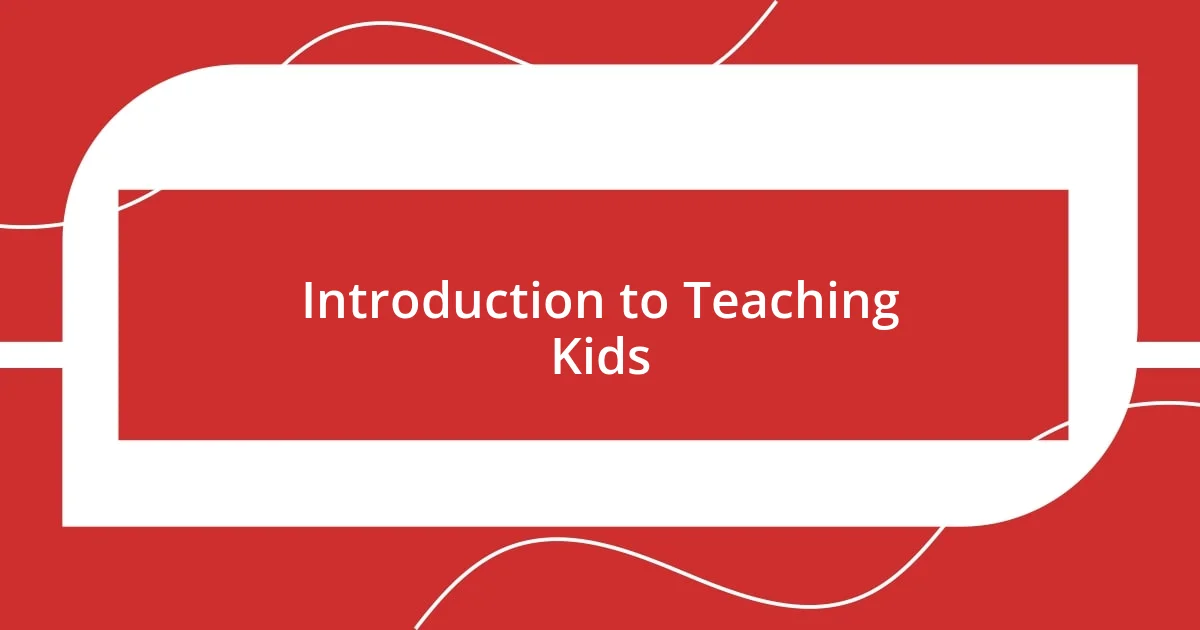Key takeaways:
- Patience and engagement are crucial when teaching kids to knit, as they spark curiosity and confidence through hands-on learning and storytelling.
- Using simple, kid-friendly materials enhances the enjoyment of knitting, making it accessible and fun for young learners.
- Celebrating small victories and fostering community through shared projects boosts children’s motivation and emotional connections to their knitting journey.

Introduction to Teaching Kids
Teaching kids can be both a delightful and daunting experience. I remember the first time I introduced knitting to my niece; her tiny fingers fumbled with the yarn while her eyes sparkled with curiosity. Have you ever witnessed that moment when a child’s face lights up with understanding? It’s truly magical.
When starting with young learners, patience is key. They often have a thousand questions buzzing in their minds, each deserving sincere answers. For instance, when my nephew asked, “Why do we use two needles?” I realized I wasn’t just teaching a skill; I was sparking a deeper appreciation for the craft. Isn’t it wonderful how a simple question can lead to a broader discussion about creativity and problem-solving?
The most rewarding part comes from watching them grow. As their skills improve, so does their confidence. I’ll never forget the pride my friend’s daughter felt when she completed her first scarf. The joy in her eyes was palpable, leaving me wondering: isn’t helping children discover new passions one of the greatest gifts we can give?

Materials Needed for Kids Knitting
When it comes to materials for kids’ knitting, simplicity is essential. I’ve found that using the right tools can make all the difference in keeping young knitters engaged. For example, I still remember my daughter attempting to knit with those fancy metal needles. Her frustration was evident, and it took a switch to softer bamboo needles for her to truly enjoy the experience.
Here’s a quick list of what you’ll need to set the stage for successful knits:
– Yarn: Choose a soft, medium-weight yarn. I prefer acrylic for its durability and ease of care.
– Needles: Opt for 9 or 10-inch bamboo or plastic needles, which are lightweight and easy to handle.
– Scissors: A small, kid-friendly pair helps manage yarn ends without too much fuss.
– Tapestry Needle: This is essential for weaving in ends; I usually choose a larger one with a blunt tip for safety.
– Stitch Markers: These can be fun for kids to use, helping them keep track of their knitting progress. Adding a splash of color makes the task more appealing!

Step-by-Step Knitting Instructions
When teaching step-by-step knitting instructions, breaking it down into clear, manageable parts works best for kids. I often start with the basics—casting on stitches. I remember sitting with my nephew, his brow furrowed in concentration as I guided his hands through the motions. It’s a beautiful moment when they finally succeed, and you can see that spark of understanding. Visual demonstrations, like using my own hands to show the movement, really help kids grasp the concept.
Next up is teaching the knit stitch, which I always describe as the foundation of their knitting journey. I break the stitch down into a series of simple movements: insert the needle, yarn over, and pull through. That’s when I encourage them to narrate what they’re doing. It’s amazing how transforming a silent activity into a storytelling moment helps cement their learning. I’ve seen it in action—when my daughter began narrating, her confidence grew, and soon enough, she was knitting away like a pro.
Finally, I teach binding off, which is the grand finale of their creation. It feels akin to finishing a project and receiving applause for a well-done performance. I vividly remember guiding my friend’s son through this stage. His eyes widened with excitement as I exclaimed, “You’re almost done!” Watching him pull the last loop through and declare, “I made this!” left me with an overwhelming sense of joy—proof that we’re not just teaching a skill, but also celebrating their creativity and accomplishments!
| Step | Description |
|---|---|
| 1. Cast On | Begin by creating a slip knot and casting on the desired number of stitches. This is like the opening act of their knitting performance! |
| 2. Knit Stitch | Introduce the knit stitch with a simple demonstration, allowing kids to practice the motion repeatedly for mastery. Encourage them to narrate their movements. |
| 3. Bind Off | Conclude by teaching them how to bind off, providing a tangible sense of achievement. Celebrate their creation and newfound skills! |

Overcoming Common Challenges
I’ve faced my fair share of challenges while teaching children to knit, and one of the most common is their initial frustration when things don’t go as planned. I recall a time when a student got tangled up in their yarn, and instead of panicking, we turned it into a fun game. I asked, “Can we untangle this without using any scissors?” Not only did they get to solve the problem creatively, but it also made them feel accomplished when they finally freed the yarn. It’s moments like these that show kids that mistakes are just part of the learning process.
Another challenge is maintaining their attention, especially during the repetitive motions involved in knitting. I’ve found that incorporating a little storytelling can work wonders. For instance, when teaching a group, I used to create a narrative around our knitting project, comparing our work to building a cozy castle for an imaginary prince or princess. This little twist not only kept the kids engaged but turned an ordinary knitting session into an adventure. How cool is it to watch their eyes light up as they connect their stitches with a story?
Lastly, it’s not uncommon for young knitters to feel overwhelmed by the learning pace. I remember watching a child honestly struggle with counting stitches. Instead of letting the moment pass, I suggested we sing a little counting song while we knitted. It turned the whole experience into a joyful rapport, and before long, she was not only counting but actually enjoying the process. It’s these creative solutions that have taught me the value of patience and adaptability in teaching. Each challenge we encounter in knitting becomes an opportunity to foster resilience and creativity.

Encouraging Kids to Continue
To encourage kids to continue knitting, I emphasize the importance of celebrating small victories. Just last week, I watched my daughter complete her first row of stitches. When I cheered her on, the glow of pride on her face was unforgettable. It’s moments like these that reinforce their sense of accomplishment. They realize that every stitch counts, and that builds their confidence to tackle more complex projects.
Engagement really plays a vital role as well. I often ask my young knitters what colors they’d like to use next or which animal they imagine wearing their creation. This turns knitting into a collaborative adventure rather than a chore. By making it personal, I’ve seen kids transform from tentative beginners into excited creators. When they own their projects, they’re much more likely to stick with it.
Finally, it’s all about building a community. I’ve organized knitting circles with friends and their kids, where we share our works in progress and swap stories. There’s magic in seeing other kids proudly display their creations. It creates a sense of belonging that encourages them to keep knitting and exploring new skills. After all, who wouldn’t want to be part of a team that celebrates creativity and friendship?

Creative Projects for Kids
One of my favorite creative projects for kids involves making simple knitted creatures. I once guided a small group to create miniature animals, and their excitement was contagious. Watching them take ownership of their designs—choosing colors and unique features—turned each creation into a little masterpiece. Who knew that a simple ball of yarn could transform into a beloved pet, sparking their imagination?
Another enjoyable project I’ve experienced is knitting gifts for family members. I recall a time when one child decided to knit a scarf for their grandmother. As we worked through the stitches, we talked about what makes gifts special and how they can convey love. It became a heartfelt experience, and the child’s face lit up when she presented her finished scarf. Isn’t it beautiful how a personal touch in a project can strengthen their emotional connections to both the craft and their loved ones?
Lastly, I often incorporate seasonal events into our knitting projects. For instance, around Halloween, I encouraged my students to knit spooky-themed decorations. I distinctly remember our laughter as we crafted tiny bats and pumpkins, which added an extra layer of festivity to the occasion. It’s amazing how such projects not only foster creativity but also create delightful memories that connect knitting with joy and celebration. How often do we get the chance to blend craft with the spirit of the season?















